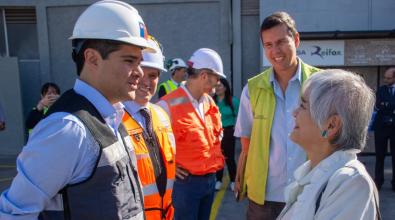 Read More
Read More
These cities are finding new ways to de-risk experimentation

Listen to This Article
Experimentation has long played a key role in city innovation, helping leaders better understand residents’ needs and assess whether new solutions can effectively meet them. But testing new ideas in government is not always easy. Concerns about liability, public expectations, and limited resources can make it difficult to try something new, even when the need is clear.
As cities manage growing demands and tighter budgets, some are finding new ways to reduce the risks associated with experimentation. The goal is to make it more practical, more affordable, and more likely to lead to action.
“Cities are often constrained around concerns with liability,” says Justin Entzminger, innovation practice director at the Bloomberg Center for Public Innovation at Johns Hopkins University. But recent efforts, including using theater to role-play potential solutions and more strategically offering public spaces for tests of new technology, show how city teams and their partners can always find new ways to experiment safely and effectively.
Staging potential problems and promising solutions for an actual audience.
As London’s Eddie Copeland sees it, piloting new solutions is both critical and uniquely difficult at a time when his city and others across the U.K. feel the pinch of tighter budgets. That’s why Copeland, who serves as the director of the London Office of Technology and Innovation (LOTI), is taking a new, low-cost approach at this work: showcasing mockups of potential service-delivery changes on an actual stage before piloting them in the field.
This effort usually starts with Copeland’s team identifying a major local challenge, such as care for aging residents, and then carrying out traditional innovation activities, such as journey mapping, to track how residents presently interact with service providers. Armed with that insight, they then pivot to something more unique, bringing in actors to perform scenes of residents going on that journey and still struggling to get what they need. One recent performance, for example, spotlighted a woman who had trouble securing care for her husband, who has early-onset Alzheimer’s disease.
The audience for these performances is as key as the problems they portray: the very providers, across local and national government, who are tasked with delivering these services.
It’s the next part of this process that Copeland is most excited about and that most underscores the potential for lower-risk experimentation. Convening key stakeholders for these performances and follow-up sessions puts the city in a unique position to ideate and iterate with all the relevant delivery partners in one room. In the above example, Copeland’s team guided everyone from National Health Service occupational therapists to local digital leads and service designers in quickly prototyping six new solutions geared at helping the woman and her husband. The ideas ranged from the decidedly analog (“care buddies” who help residents like her navigate the system) to a tool that uses behavioral nudges to streamline referrals for city services and then taps AI to triage those requests inside agencies.
Finally, the London team presents proposed interventions on stage at a subsequent convening, so the audience can see how they work before deciding which ones to move forward with. It’s an approach that, according to Copeland, is both low-cost (the biggest expense is for a venue to host the event) and can be used to play out any new solution without placing new burdens on service providers.
“You can be as radical as you want, because you're not risking any frontline services,” he says.
Sharing the risks and benefits of developing new technologies.
The so-called sandbox, where cities allow the private sector and academia to test new services and solutions in designated spaces before bringing them to the wider market, is an already well-known tool for de-risking innovation. Yet now cities are taking new steps both to better align this work with resident needs and to extract more public value along the way. In doing so, they’re also shaping urban markets for the greater good.
Take Valencia, Spain. The city’s Urban Sandbox initiative, which launched last summer, mirrors its predecessors in some basic respects by providing proving grounds for entrepreneurs and academics pursuing new products and solutions. The city offers about 150 public resources—from parks, squares, and public buildings to pieces of infrastructure such as streetlights and buses, and even city events—to serve as “monitored testing environments,” as the city describes them. The de-risking here is in providing a safe space for firms and researchers to iterate, fail, and try again.
But Valencia is doing things differently than cities have with past sandboxes in two key ways: by being strategic about which new products are allowed inside the sandbox and by systematically extracting public value for residents from its use.
“We are reducing the risk of the external innovation process, but they have to demonstrate that it is aligned with the city's objectives,” explains Valencia Director of Innovation Fermín Cerezo Peco. For example, one of the products residents might recently have seen in the city is an AI-powered robot that cleans public beaches. As Mayor María José Catalá explained when the device debuted last July, it was chosen for a reason: Cleaning the coastline is a top priority for her government.
In addition to backing private-sector activity aligned with its goals, Valencia is working to ensure residents benefit from these experiments in other ways. For instance, baked into the city’s agreements with participating companies are profit-sharing and knowledge-sharing provisions. So the city is using its sandbox approach to put itself in position to generate revenue and, critically, expertise for its own future use.
“There is no other way to access that knowledge and know what is coming next,” Cerezo explains.
What connects the work in London and Valencia is the recognition that cities have obligations the private sector does not. That means they must constantly adapt—not just what they try, but how they try it. Doing so enables them to meet residents’ needs without compromising public trust.
As JHU’s Entzminger says, “It’s exciting to see cities getting creative with how they construct safe spaces to demonstrate what can be done when the first and last goal is resident impact.”

